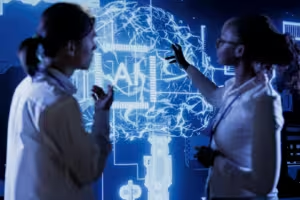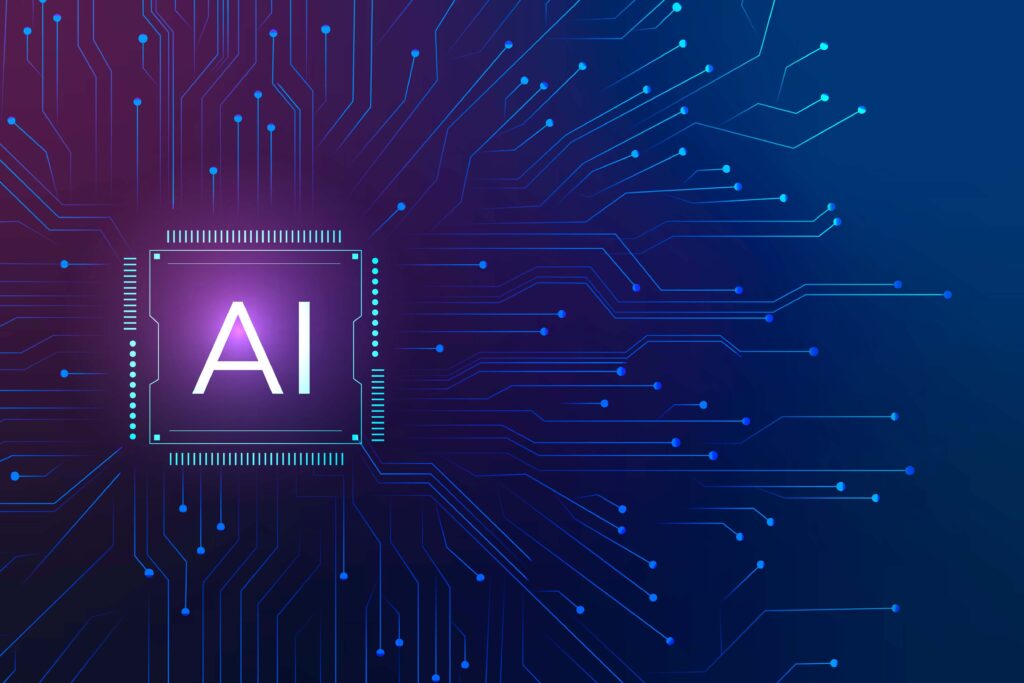Artificial Intelligence (AI) refers to the simulation of human intelligence in machines that are programmed to think and learn like humans. It encompasses various technologies like machine learning and natural language processing, enabling computers to analyze data, recognize patterns, and make decisions with minimal human intervention. AI applications range from virtual assistants like Siri to self-driving cars and advanced medical diagnostics, revolutionizing industries by automating tasks, improving efficiency, and driving innovation.
What is Artificial Intelligence (AI)?
Artificial Intelligence refers to the simulation of human intelligence in machines designed to think and act like humans. These machines are programmed to perform tasks that typically require human intelligence, such as visual perception, speech recognition, decision-making, and language translation. The ultimate goal of AI is to create systems that can function intelligently and independently.
How Does AI Work?
Artificial Intelligence (AI) works by using algorithms and computational models to mimic human cognitive processes. The goal is to create systems that can learn, reason, and make decisions autonomously. Here’s a detailed breakdown of how AI works:
Data Collection and Preparation
The foundation of any AI system is data. AI systems require vast amounts of data to learn and make informed decisions. This data can come from various sources, including sensors, databases, online content, and user interactions.
1. Data Collection
Data collection involves gathering raw data from multiple sources. For example, self-driving cars collect data from cameras, radar, and LIDAR sensors. In healthcare, data can come from patient records, medical imaging, and clinical trials.
2. Data Cleaning and Preprocessing
Raw data often contains noise, errors, and inconsistencies. Data cleaning involves removing or correcting these issues to ensure the data is accurate and reliable. Preprocessing includes normalizing, scaling, and transforming data into a format suitable for AI algorithms.
Algorithms and Models
AI systems rely on algorithms and models to process data and learn from it. These algorithms can be broadly categorized into three types: supervised learning, unsupervised learning, and reinforcement learning.
1. Supervised Learning
In supervised learning, the algorithm is trained on labeled data, where each data point has an associated label or output. The goal is to learn a mapping from inputs to outputs. Common supervised learning algorithms include linear regression, decision trees, and neural networks.
Example: In image recognition, a supervised learning algorithm is trained on a dataset of labeled images (e.g., cats, dogs, cars). The algorithm learns to identify features and classify new images based on this training.
2. Unsupervised Learning
Unsupervised learning deals with unlabeled data. The algorithm tries to find patterns, relationships, or structures within the data. Common unsupervised learning algorithms include clustering (e.g., K-means) and dimensionality reduction (e.g., PCA).
Example: In customer segmentation, an unsupervised learning algorithm groups customers based on purchasing behavior without predefined labels, helping businesses tailor marketing strategies.
3. Reinforcement Learning
Reinforcement learning involves training an agent to make decisions by interacting with an environment. The agent receives feedback in the form of rewards or penalties and aims to maximize cumulative rewards over time. This approach is commonly used in robotics, gaming, and autonomous systems.
types of Artificial Intelligence
AI can be broadly categorized into three types:
1. Narrow AI (Weak AI)
Narrow AI is designed to perform specific tasks within a limited scope. These systems are highly specialized and can outperform humans in their specific tasks but lack general intelligence. Examples include virtual assistants like Siri and Alexa, recommendation algorithms on Netflix and Amazon, and autonomous vehicles.
2. General AI (Strong AI)
General AI refers to machines that possess the ability to understand, learn, and apply knowledge across a wide range of tasks, similar to human intelligence. General AI remains theoretical and is a long-term goal for researchers.
3. Superintelligent AI
Superintelligent AI surpasses human intelligence in all aspects, including creativity, problem-solving, and emotional understanding. This level of AI is purely hypothetical and raises ethical and existential questions.
Applications of Artificial Intelligence
AI’s applications are vast and varied, impacting numerous sectors:
1. Healthcare
AI is revolutionizing healthcare by improving diagnostics, personalized treatments, and patient care. Machine learning algorithms analyze medical data to predict disease outcomes, while AI-powered robots assist in surgeries.
Example: IBM Watson for Oncology uses AI to analyze patient data and provide evidence-based treatment recommendations, enhancing the decision-making process for oncologists.
2. Finance
AI algorithms help detect fraudulent transactions, automate trading, and provide personalized financial advice. These systems analyze vast amounts of data to make informed decisions, reducing risks and increasing efficiency.
Example: JPMorgan Chase’s COiN platform uses AI to review legal documents and extract relevant data, significantly reducing the time and effort required for manual processing.
3. Retail
AI enhances the retail experience through personalized recommendations, inventory management, and customer service. Retailers use AI to analyze consumer behavior and optimize supply chains.
Example: Amazon’s recommendation system uses AI to suggest products based on browsing history and purchase behavior, driving sales and improving customer satisfaction.
4. Transportation
AI is at the core of autonomous vehicles, optimizing routes, improving safety, and reducing traffic congestion. These systems rely on machine learning algorithms to interpret sensor data and make real-time decisions.
Example: Tesla’s Autopilot system uses AI to enable self-driving capabilities, enhancing driver assistance and safety features.
5. Manufacturing
AI-powered robots and automation systems increase efficiency, reduce errors, and improve quality control in manufacturing processes. Predictive maintenance powered by AI ensures equipment reliability and minimizes downtime.
Example: General Electric uses AI to predict equipment failures in its factories, allowing for proactive maintenance and reducing production disruptions.

Benefits of Artificial Intelligence
AI offers numerous benefits across various domains:
1. Enhanced Efficiency
AI automates repetitive tasks, allowing humans to focus on more complex and creative activities. This leads to increased productivity and operational efficiency.
2. Improved Accuracy
AI systems can analyze vast amounts of data with high precision, reducing errors and improving decision-making processes.
3. Cost Savings
By automating tasks and optimizing processes, AI helps businesses save costs on labor, maintenance, and operations.
4. Personalization
AI enables personalized experiences for users, from tailored recommendations to customized marketing campaigns, enhancing customer satisfaction and engagement.
5. Innovation
AI drives innovation by enabling the development of new products, services, and solutions that were previously unimaginable.
Challenges and Ethical Considerations
Despite its potential, AI also presents challenges and ethical concerns:
1. Job Displacement
The automation of tasks by AI can lead to job displacement in certain industries, requiring workforce reskilling and adaptation.
2. Bias and Fairness
AI systems can inherit biases from training data, leading to unfair and discriminatory outcomes. Ensuring fairness and transparency in AI algorithms is crucial.
3. Privacy
The use of AI in data analysis raises concerns about privacy and data security. Proper regulations and safeguards are necessary to protect user information.
4. Accountability
Determining accountability for AI decisions, especially in critical areas like healthcare and autonomous driving, is a complex issue that requires careful consideration.
The History of Artificial Intelligence (AI)
Artificial Intelligence (AI) has a rich history that spans several decades, marked by significant milestones and transformative developments. This comprehensive guide explores the evolution of AI from its early conceptualization to its current state, highlighting key events, breakthroughs, and influential figures.
Early Concepts and Foundations
1. Ancient and Classical Era
The idea of artificial beings and intelligent automata dates back to ancient mythology and classical philosophy. Ancient Greeks imagined mechanical men in their myths, while philosophers like Aristotle speculated about the nature of thought and intelligence.
2. 17th and 18th Centuries
The foundations of AI were laid during the scientific revolution, with the development of mechanical calculators and formal logic. Key figures include:
- René Descartes: Proposed the idea of mechanistic human behavior.
- Gottfried Wilhelm Leibniz: Developed the binary number system, essential for modern computing.
The Birth of AI: 1950s
1. Alan Turing and the Turing Test
In 1950, British mathematician Alan Turing published his seminal paper “Computing Machinery and Intelligence,” introducing the concept of the Turing Test to determine whether a machine can exhibit human-like intelligence.
2. The Dartmouth Conference
In 1956, the term “Artificial Intelligence” was coined during the Dartmouth Conference, organized by John McCarthy, Marvin Minsky, Nathaniel Rochester, and Claude Shannon. This event is considered the birth of AI as an academic discipline.
The Early Years: 1950s-1970s
1. Early AI Programs
The late 1950s and 1960s saw the development of some of the first AI programs, including:
- Logic Theorist (1955): Developed by Allen Newell and Herbert A. Simon, it proved mathematical theorems.
- ELIZA (1966): Created by Joseph Weizenbaum, this early natural language processing program simulated a psychotherapist.
2. Growth of AI Research
During this period, AI research expanded with the establishment of AI labs at institutions like MIT and Stanford. Key researchers included Marvin Minsky, John McCarthy, and Herbert A. Simon, who made significant contributions to AI theory and applications.
The AI Winter: 1970s-1980s
1. Unrealistic Expectations and Funding Cuts
The initial excitement around AI led to unrealistic expectations about its capabilities. When AI systems failed to deliver on these expectations, funding and interest in AI research declined, leading to the “AI Winter.”
2. Challenges and Limitations
During the AI Winter, researchers faced significant challenges, including limited computing power, insufficient data, and difficulties in creating intelligent systems that could perform complex tasks.
Revival and Progress: 1980s-2000s
1. Expert Systems
In the 1980s, AI experienced a revival with the development of expert systems, which used rule-based approaches to mimic human expertise in specific domains. Notable examples include:
- MYCIN: An expert system for diagnosing bacterial infections and recommending treatments.
- DENDRAL: Used for chemical analysis and molecular structure determination.
2. Advances in Machine Learning
The late 1980s and 1990s saw advances in machine learning, including the development of neural networks and algorithms for supervised and unsupervised learning. Researchers like Geoffrey Hinton, Yann LeCun, and Yoshua Bengio made significant contributions to neural network research.
3. Robotics and Autonomous Systems
AI also made strides in robotics, with the development of autonomous systems capable of navigating and performing tasks in dynamic environments. Notable projects included the Mars rovers and autonomous vehicles.
The Modern Era: 2000s-Present
1. Big Data and Computing Power
The explosion of big data and advancements in computing power have driven significant progress in AI. Machine learning models can now process vast amounts of data to learn and make predictions with unprecedented accuracy.
2. Deep Learning Revolution
The 2010s saw the rise of deep learning, a subset of machine learning that uses deep neural networks to model complex patterns in data. Breakthroughs in deep learning have led to remarkable achievements in image recognition, natural language processing, and game playing.
Example: Google’s DeepMind developed AlphaGo, which defeated the world champion Go player, demonstrating the power of deep learning and reinforcement learning.
3. AI in Everyday Life
AI has become integral to everyday life, powering technologies such as virtual assistants (e.g., Siri, Alexa), recommendation systems (e.g., Netflix, Amazon), and autonomous vehicles. AI-driven applications are now ubiquitous in healthcare, finance, retail, and more.
4. Ethical and Societal Considerations
As AI technology advances, ethical and societal considerations have come to the forefront. Issues such as bias, privacy, job displacement, and the ethical use of AI are now critical topics of discussion among researchers, policymakers, and the public.
Conclusion
Artificial Intelligence is a rapidly evolving field with immense potential to transform various aspects of our lives. From healthcare to finance, retail to transportation, AI’s applications are vast and impactful. While AI brings numerous benefits, it also poses challenges and ethical considerations that need to be addressed. By understanding AI’s capabilities and limitations, we can harness its power responsibly and drive innovation for a better future.
In this comprehensive guide, we have explored the definition, types, applications, benefits, and real-world examples of AI. This knowledge equips you with a foundational understanding of AI, enabling you to appreciate its significance and potential in today’s world.
